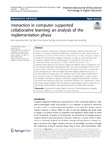Interaction in Computer Supported Collaborative Learning: An Analysis of the Implementation Phase

Use este enlace para citar
http://hdl.handle.net/2183/26044
A non ser que se indique outra cousa, a licenza do ítem descríbese como Atribución 4.0 Internacional
Coleccións
- GI-EIRA - Artigos [30]
Metadatos
Mostrar o rexistro completo do ítemTítulo
Interaction in Computer Supported Collaborative Learning: An Analysis of the Implementation PhaseData
2020Cita bibliográfica
Hernández-Sellés, N., Muñoz-Carril, P. & González-Sanmamed, M. Interaction in computer supported collaborative learning: an analysis of the implementation phase. Int J Educ Technol High Educ 17, 23 (2020). https://doi.org/10.1186/s41239-020-00202-5
Resumo
[Abstract] There is extensive research on interaction frameworks in distance education and
studies in Computer Supported Collaborative Learning (CSCL) have also focused on
establishing interaction models. There is still research to be done, though, in order to
identify the elements that configure interaction to build up a framework for their
integration, aligned with the learning goals. The purpose of this study is to
understand the key elements that configure effective interaction in the
implementation phase of CSCL and to analyze the different types of interactions that
occur during collaborative learning processes. The study was designed under a nonexperimental
quantitative methodology and 106 learners answered a questionnaire
after participating in 5 different higher education subjects implementing CSCL. A
factorial analysis of results prove that students identify three types of interaction to
be necessary during the implementation phase of collaboration in order to reach
knowledge convergence: cognitive, social and organizational interaction. Therefore,
instructors and institutions who wish to promote effective CSCL should bear in mind
the learning goals together with the social and organizational aspects interwoven in
the design, implementation and assessment phases of collaborative learning.
Palabras chave
Collaborative learning
Higher education
Teaching/learning strategies
Computer-mediated communication
Interactive learning
Higher education
Teaching/learning strategies
Computer-mediated communication
Interactive learning
Versión do editor
Dereitos
Atribución 4.0 Internacional






